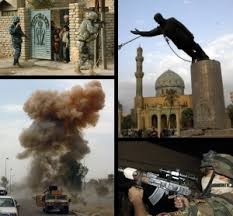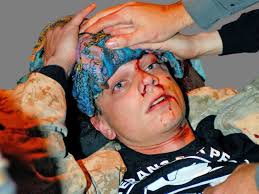War zone crime rise 
A Marine in Iraq sent home $43,000 in stolen cash by hiding it in a footlocker among American flags. A soldier shipped thousands more concealed in a toy stuffed animal. An embassy employee tricked the State Department into wiring $240,000 into his foreign bank account.
As the wars in Iraq and Afghanistan wind down, the number of people indicted and convicted by the U.S. for bribery, theft and other reconstruction-related crimes in both countries is rapidly rising, according to two government reports released Sunday.
"This is a boom industry for us," Stuart Bowen, the special inspector general for Iraq reconstruction, said in an interview.
"Investigators and auditors had a productive quarter," said a report on the theft of Afghanistan aid by Steven Trent, who holds the same job for Afghanistan. His report covered August through October.
In the past 13 months U.S. investigators in Iraq secured the indictments of 22 people for alleged aid-related offenses, bringing to 69 the total since the SIGIR office was created in 2004. Convictions stand at 57. Several hundred more suspects are under scrutiny in 102 open investigations and those numbers are expected to climb.
The rise in caseloads derives partly from spinoff investigations, where suspects facing prosecution lead investigators to other suspects, said Jon Novak, SIGIR's assistant inspector general for investigations.
"More and more people are ratting out their associates," he said, turning in conspirators who helped launder money after it was stolen, others who were aware of it and others implicated in the crimes.
As investigators gain experience, they're received better information from a growing network of sources in Iraq, said Dan Willkens, Novak's deputy. Development of an automated data-mining system for investigations has helped, he said, as did a decision two years ago to speed prosecutions by hiring three former assistant U.S. attorneys and detailing them to the Justice Department.
At the inspector general's office for Afghan reconstruction, created in 2008, officials report only nine indictments and seven convictions so far. They say they're trying to ramp up after years of upheaval and charges the office was mismanaged. Trent was named acting inspector general after his predecessor left in August and is the third person to hold the job.
Still, Trent reported that during the last quarter, an investigation initiated by his office netted the largest bribery case in Afghanistan's 10-year war. A former Army Reserve captain, Sidharth "Tony" Handa of Charlotte, N.C., was convicted, sentenced to prison and fined for soliciting $1.3 million in bribes from contractors working on reconstruction projects.
Most crimes uncovered by U.S. investigators in the two war zones include bribery, kickbacks and theft, inspired in part by the deep and pervasive cultures of corruption indigenous to the countries themselves.
Among some of the cases listed in the reports were those of:
• Gunnery Sgt. Eric Hamilton, who pleaded guilty to conspiracy in what prosecutors say was a scheme to help Iraqi contractors steal 70 generators that were meant to supply electricity for fellow Marines. He sent some of their payments home in a footlocker and had other money wired, the report said.
• Several U.S. government employees, who received kickbacks for steering contracts to local conspirators and providing inside information to people competing for contracts. A former army sergeant, who was not identified, is charged with pocketing more than $12,000 in cash that a contractor never picked up after the money was allegedly stolen by another army sergeant and mailed to California inside a stuffed animal.
• Jordanian national and U.S. Embassy employee Osama Esam Saleem Ayesh, who was convicted in April for stealing nearly $240,000 intended to cover shipping and customs charges the State Department incurs when it moves household goods of its employees. The money wound up in Ayesh's bank in Jordan.
Money stolen from reconstruction projects also has been shipped off of U.S. battlefields tucked into letters home and stuffed in a military vest. Tens of thousands of dollars were once sewn into a Santa Claus suit.
Prosecutors have retrieved some of the money. More than $83 million will be returned to the U.S. from Iraq cases completed in the budget year that ended Sept. 30, bringing the total recovered over the last seven years to nearly $155 million, Bowen's office said.
As well as stolen cash, the total includes court-ordered restitution, fines and proceeds from the sale of merchandise seized from those convicted, including Rolex watches, luxury cars, plasma TVs and houses.
‘EGREGIOUS’ FRAUD
Prosecutions by Trent's office recovered $51 million over the past year, his report said.
But the amount recovered is believed to be a tiny fraction of what's been stolen in the two war zones, a figure that will probably never be known for certain. Far more money is believed to have been lost through waste and abuse that resulted from poor management and the often-questioned U.S. strategy of trying to rebuild nations that are still at war.
The U.S. has committed $62 billion to rebuilding Iraq and $72 billion for the reconstruction of Afghanistan.
The independent Commission on Wartime Contracting estimated in August that at least $31 billion has been lost to waste and fraud in Iraq and Afghanistan, adding that the total could be as high as $60 billion. It studied not just reconstruction spending, but $206 billion for the logistical support of coalition forces and the performance of security functions.
The commission found that from 10 to 20 percent of the $206 billion in spending was wasted, while fraud accounted for the loss of another 5 percent to 9 percent.
Bowen called the cost of fraud "egregious."
"This is open crime occurring in a war zone," he said. "And the purpose of a lot of these expenditures is to win hearts and minds. Obviously we lose hearts and minds" when local populations see foreigners steal money meant to help rebuild their country.
The inspectors general are only two of the U.S. government offices looking into fraud, waste and abuse. Others include State Department inspectors and Army criminal investigators.
By Pauline Jelinek - The Associated Press
Email ThisBlogThis!Share to TwitterShare to Facebook 0 comments 
 Links to this post second Iraq war veteran injured
Links to this post second Iraq war veteran injured 
A second Iraq war veteran has suffered serious injuries after clashes between police and Occupy movement protesters in Oakland.
Kayvan Sabehgi, who served in Iraq and Afghanistan, is in intensive care with a lacerated spleen. He says he was beaten by police close to the Occupy Oakland camp, but despite suffering agonising pain, did not reach hospital until 18 hours later.
Sabehgi, 32, is the second Iraq war veteran to be hospitalised following involvement in Oakland protests. Another protester, Scott Olsen, suffered a fractured skull on 25 October.
On Wednesday night, police used teargas and non-lethal projectiles to drive back protesters following an attempt by the Occupy supporters to shut down the city of Oakland.
Sabehgi told the Guardian from hospital he was walking alone along 14th Street in central Oakland – away from the main area of clashes – when he was injured."There was a group of police in front of me," he told the Guardian from his hospital bed. "They told me to move, but I was like: 'Move to where?' There was nowhere to move.
"Then they lined up in front of me. I was talking to one of them, saying 'Why are you doing this?' when one moved forward and hit me in my arm and legs and back with his baton. Then three or four cops tackled me and arrested me."
Sabeghi, who left the army in 2007 and now part-owns a small bar-restaurant in El Cerrito, about 10 miles north of Oakland, said he was handcuffed and placed in a police van for three hours before being taken to jail. By the time he got there he was in "unbelievable pain".
He said: "My stomach was really hurting, and it got worse to the point where I couldn't stand up.
"I was on my hands and knees and crawled over the cell door to call for help."A nurse was called and recommended Sabehgi take a suppository, but he said he "didn't want to take it".He was allowed to "crawl" to another cell to use the toilet, but said it was clogged.
"I was vomiting and had diarrhoea," Sabehgi said. "I just lay there in pain for hours."Sabehgi's bail was posted in the mid-afternoon, but he said he was unable to leave his cell because of the pain. The cell door was closed, and he remained on the floor until 6pm, when an ambulance was called.
He was taken to Highland hospital – the same hospital where Olsen was originally taken after being hit in the head by a projectile apparently fired by police.
Sabehgi was due to undergo surgery on Friday afternoon to repair his spleen, which would involve using a clot or patch to prevent internal bleeding.
Thousands of protesters had attended the action in Oakland on Wednesday, taking over the downtown area of the city and blockading Oakland's port.As demonstrations continued near the camp base at Frank H Ogawa plaza during the evening, a group of protesters occupied a disused building on 16th Street at around 10.30pm, with some climbing up onto the roof.
There had been little police presence during the day, but more than 200 officers arrived after 11pm. Some protesters had set fire to a hastily assembled barrier at the corner of 16th Street and Telegraph, in a bid to prevent access to the occupied building, but police drove demonstrators away from 16th Street using tear gas, flashbang grenades, and non-lethal rounds.
Sabehgi said he had not been in the occupied building, and was walking away from the main area of trouble when he was injured.
He said he had his arms folded and was "totally peaceful" before being arrested.
A spokeswoman for Highland hospital confirmed Sabehgi had been admitted. Oakland police were not immediately available for comment.Adam Gabbatt,
guardian.co.uk 




